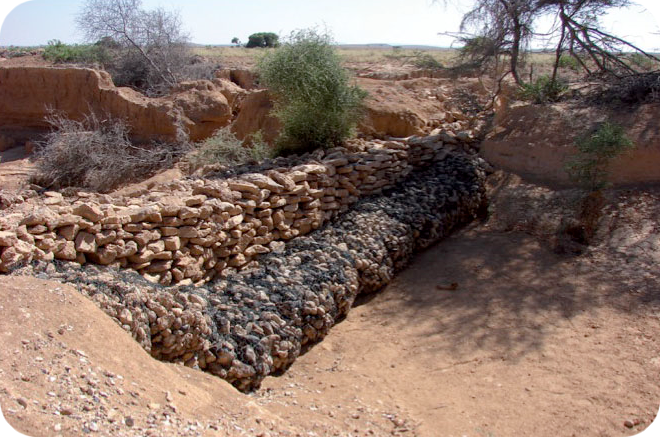Application: Aquifers, bore wells, dug wells, culverts and drains, dykes, farms
Description: A check dam (also called gully plug) is a small, temporary or permanent dam built across a drainage ditch, swale, or channel to lower run-off speed. By reducing the original gradient of the gully channel, erosion and gully erosion are prevented and sediments and pollutants settle. Furthermore, it allows groundwater recharge and possibly retains soil moisture due to infiltration. It can be built from wooden logs, stone, pea-gravel filled sandbags or bricks and cement. Tree seedlings, as well as shrub and grass cuttings planted in gullies, can grow without being washed away by flowing water. Thus, a permanent vegetative cover can be established in a short time. Temporary structural measures such as woven-wire, brushwood, logs, loose stones and boulder check dams are used to facilitate the growth of this permanent vegetative cover. Depending on the topography, amount of precipitation, material and financial resources available, there are several methods to construct a gully plug.
Contribution to climate resilience: By reducing water speed during floods, vegetated check dams reduce erosion. They also improve water availability by contributing to groundwater recharge. Because they are constructed by labour and materials available locally, they require less energy to produce, are far more sustainable, and can often be applied in a quicker timeframe than traditional civil engineering works.
Supplementary sources of information:
http://www.sswm.info/content/check-dams-gully-plugs
http://www.sswm.info/sites/default/files/reference_attachments/POLYTECHNIC%20ny%20Check%20Dam.pdf
Background image credit: https://pxhere.com/en/photo/1020786
This resilience-building measure is sourced from the Water Resource Adaptation Guide (2019) published by the National Council for Sustainable Development at the Ministry of Environment in Cambodia. The full Guide is available to download at URL https://ncsd.moe.gov.kh/sites/default/files/2019-10/Water%20Resources%20Adaptation%20Guide_March%202019_En.pdf


